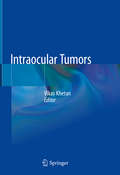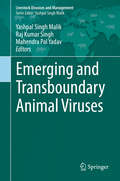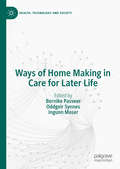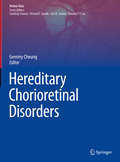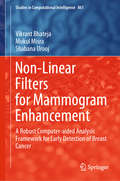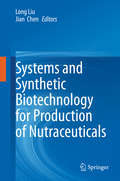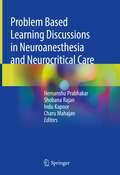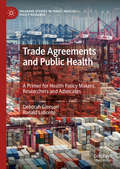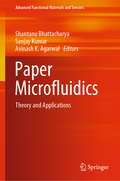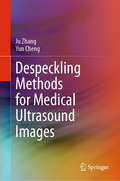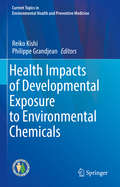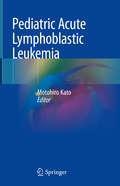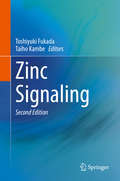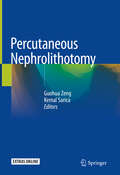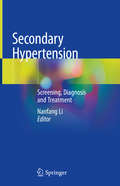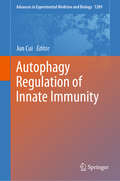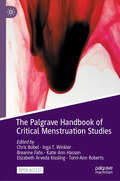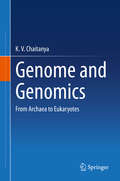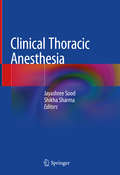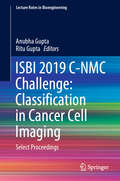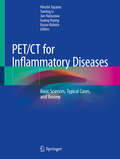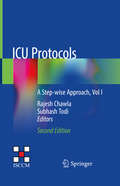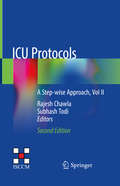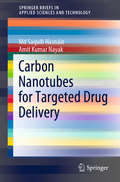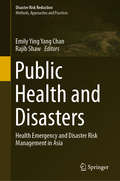- Table View
- List View
Intraocular Tumors
by Vikas KhetanThis book aims to cover all aspects of intraocular tumors. The chapters explain diagnosis and treatment plan in detail with the aid of step-by-step descriptions in the form of flow charts. An additional chapter covers imaging modalities that help in diagnosing these conditions. The book is written by subject experts from all over the world. The book includes latest treatment protocols and changing trends in management of ocular tumors. Chapter with special focus on genetics is included to help clinicians understand the condition better.
Emerging and Transboundary Animal Viruses (Livestock Diseases and Management)
by Yashpal Singh Malik Raj Kumar Singh Mahendra Pal YadavThis book, which is the first volume of the book series-Livestock Diseases and Management, summarizes the prominence and implications of the emerging and transboundary animal viruses. Although the livestock plays an important role in the economy of many countries, the emerging and transboundary animal viral diseases possess a serious risk to the animal-agriculture sector and food security globally. The book describes the precise and up-to-date information on animal viral diseases which have emerged in the recent past or are re-emerging due to various environmental factors and those which are not bounded in restricted national boundaries and attained the transboundary status. The chapters summarize the recent advancements in the molecular state-of-art tools towards the development of diagnostics, prophylactics, and therapeutics of these viruses. It also explicitly describes the challenges imposed by the emerging and transboundary viral infections and our preparedness to counter them.
Ways of Home Making in Care for Later Life (Health, Technology and Society)
by Bernike Pasveer Oddgeir Synnes Ingunn MoserThis is a book on how home is made when care enters the lives of people as they grow old at home or in ‘homely’ institutions. Throughout the book, contributors show how home is a verb: it is something people do. Home is thus always in the making, temporal, contested, and open to negotiation and experimentation. By bringing together approaches from STS, anthropology, health humanities and health care studies, the book points to the importance of people's tinkerings and experiments with making home, as it is here that home is being made and unmade.
Hereditary Chorioretinal Disorders (Retina Atlas)
by Gemmy CheungThis volume of the retina atlas focuses on hereditary chorioretinal disorders. The topics covered include retinitis pigmentosa, Best disease, congenital X-linked retinoschisis, cone dystrophy, Stargardt’s disease, pattern dystrophy, North Carolina macular dystrophy, choroideremia, Mallattia Leventinese, Bietti’s crystalline dystrophy, and albinism. All clinical features are clearly illustrated with multimodal imaging techniques. The utility of some of the latest imaging tools such as OCT angiography, adaptive optics-scanning laser ophthalmoscopy, and microperimetery is discussed. Readers will gain valuable new insights into pathogenesis at the molecular level, which have been facilitated by recent genetic discoveries. The use of genetic testing and the latest advances in and challenges of gene therapy and cell-based therapy are also covered in detail.Hereditary Chorioretinal Disorders atlas is one of nine volumes in the series Retina Atlas. The series provides validated and comprehensive information on vitreoretinal diseases, covering imaging basics, retinal vascular diseases, macular disorders, ocular inflammatory and infectious disorders, retinal degeneration, the surgical retina, ocular oncology, pediatric retina and trauma.
Non-Linear Filters for Mammogram Enhancement: A Robust Computer-aided Analysis Framework for Early Detection of Breast Cancer (Studies in Computational Intelligence #861)
by Vikrant Bhateja Mukul Misra Shabana UroojThis book presents non-linear image enhancement approaches to mammograms as a robust computer-aided analysis solution for the early detection of breast cancer, and provides a compendium of non-linear mammogram enhancement approaches: from the fundamentals to research challenges, practical implementations, validation, and advances in applications.The book includes a comprehensive discussion on breast cancer, mammography, breast anomalies, and computer-aided analysis of mammograms. It also addresses fundamental concepts of mammogram enhancement and associated challenges, and features a detailed review of various state-of-the-art approaches to the enhancement of mammographic images and emerging research gaps. Given its scope, the book offers a valuable asset for radiologists and medical experts (oncologists), as mammogram visualization can enhance the precision of their diagnostic analyses; and for researchers and engineers, as the analysis of non-linear filters is one of the most challenging research domains in image processing.
Systems and Synthetic Biotechnology for Production of Nutraceuticals
by Long Liu Jian ChenThis book discusses systems and synthetic biotechnologies for the production of nutraceuticals, and summarizes recent advances in nutraceutical research in terms of the physiological effects on health, potential applications, drawbacks of traditional production processes, characteristics of production strains, and advances in microbial production based on systems and synthetic biotechnology. It also examines future directions in the microbial production of nutraceuticals using systems and synthetic biology. The book is intended for researchers and graduate students in the field of molecular biology and industrial biotechnology as well as staff working in the nutraceutical industry.
Problem Based Learning Discussions in Neuroanesthesia and Neurocritical Care
by Hemanshu Prabhakar Charu Mahajan Indu Kapoor Shobana RajanThis book presents a student-centric, problem-based approach to learning key issues in neuroanesthesia and neurocritical care, a concept that is gaining popularity and acceptance in the medical education field. Each chapter starts with a brief case scenario describing the condition, followed by series of questions and answers covering important aspects like differential diagnosis, associated co-morbidity, preoperative evaluation and preparation, intraoperative anesthetic management, postoperative management and prognosis. Featuring questions to engage readers, and providing answers based on reason and supported by evidence and references, the book is a valuable educational aid for trainees and residents. It also offers insights into the real-world clinical situations, making it of interest to practicing anesthesiologists and neuroanesthesiologists.
Trade Agreements and Public Health: A Primer for Health Policy Makers, Researchers and Advocates (Palgrave Studies in Public Health Policy Research)
by Deborah Gleeson Ronald LabontéThe need for policy coherence between trade and health has never been greater, yet few public health workers are equipped to navigate this complex field. This book aims to fill this gap, providing a focused and readable introduction to the topic. It introduces the principles underpinning trade treaties and examines the implications of trade rules for health services and access to medicines, unhealthy commodities, labour rights and the environment. It explores the trade policy making process, methods for trade and health research, and recommendations for strengthening policy coherence.
Paper Microfluidics: Theory and Applications (Advanced Functional Materials and Sensors)
by Shantanu Bhattacharya Sanjay Kumar Avinash K. AgarwalThis volume provides an overview of the recent advances in the field of paper microfluidics, whose innumerable research domains have stimulated considerable efforts to the development of rapid, cost-effective and simplified point-of-care diagnostic systems. The book is divided into three parts viz. theoretical background of paper microfluidics, fabrication techniques for paper-based devices, and broad applications. Each chapter of the book is self-explanatory and focuses on a specific topic and its relation to paper microfluidics and starts with a brief description of the topic’s physical background, essential definitions, and a short story of the recent progress in the relevant field. The book also covers the future outlook, remaining challenges, and emerging opportunities. This book shall be a tremendous up-to-date resource for researchers working in the area globally.
Despeckling Methods for Medical Ultrasound Images
by Ju Zhang Yun ChengBased upon the research they have conducted over the past decade in the field of denoising processes for medical ultrasonic imaging, in this book, the authors systematically present despeckling methods for medical ultrasonic images. Firstly, the respective methods are reviewed and divided into five categories. Secondly, after introducing some basic mathematical tools such as wavelet and shearlet transforms, the authors highlight five recently developed despeckling methods for medical ultrasonic images. In turn, simulations and experiments for clinical ultrasonic images are presented for each method, and comparison studies with other well-known existing methods are conducted, showing the effectiveness and superiority of the new methods. Students and researchers in the field of signal and image processing, as well as medical professionals whose work involves ultrasonic diagnosis, will greatly benefit from this book. Familiarizing them with the state of the art in despeckling methods for medical ultrasonic images, it offers a useful reference guide for their study and research work.
Health Impacts of Developmental Exposure to Environmental Chemicals (Current Topics in Environmental Health and Preventive Medicine)
by Reiko Kishi Philippe GrandjeanThis book provides concise and cutting-edge studies on threats resulting from exposure to environmental chemicals that can affect human health and development, with a particular emphasis on the DOHaD concept. The book is divided into five main parts, the first of which includes an introduction to the impacts of developmental exposure to environmental chemicals and historical perspectives, while the second focuses on how environmental chemicals can affect human organs, including neurodevelopment, immune functions, etc. In turn, the third part addresses the characteristics of specific chemicals and their effects on human health and development, while the fourth part provides a basis for future studies by highlighting the latest innovations in toxicology, remaining challenges, and promising strategies in children’s environmental health research, as well as ideas on how to bridge the gap between research evidence and practical policymaking. The fifth and last part outlines further research directions and related policymaking aspects. Health Impacts of Developmental Exposure to Environmental Chemicals will appeal to young and veteran researchers, students, and physicians (especially gynecologists and pediatricians) who are seeking comprehensive information on how children’s health can be affected by harmful chemicals and other environmental toxicants.
Pediatric Acute Lymphoblastic Leukemia
by Motohiro KatoThis book discusses key aspects of childhood acute lymphoblastic leukemia (ALL), presenting the latest research on the biology and treatment of the disease and related issues. The cure rate for ALL has improved dramatically due to advances such as supportive care, treatment stratification based on relapse risk, and the optimization of treatment regimens. Gathering contributions by eminent scholars Pediatric Acute Lymphoblastic Leukemia is a valuable resource for pediatric hematologists as well as for medical students, interns, residents and fellows. It not only offers comprehensive insights, but also provides a springboard for future research.
Zinc Signaling
by Toshiyuki Fukada Taiho KambeThis book, now in an extensively revised second edition, describes the crucial role of zinc signaling in biological processes on a molecular and physiological basis. Global leaders in the field review the latest knowledge, including the very significant advances in understanding that have been achieved since publication of the first edition. Detailed information is provided on all the essentials of zinc signaling, covering molecular aspects and the roles of zinc transporters, the zinc sensing receptor, and metallothioneins. Detection techniques for zinc signals, involving genetically encoded and chemical probes, are also described. The critical contributions of the zinc signal in maintaining health and the adverse consequences of any imbalance in the signal are then thoroughly addressed. Here, readers will find up-to-date information on the significance of the zinc signal in a wide range of conditions, including cardiovascular disorders, neurodegenerative diseases, diabetes, autoimmune diseases, inflammatory conditions, skin disease, osteoarthritis, and cancer. The book will be of value for researchers, clinicians, and advanced students.
Percutaneous Nephrolithotomy
by Guohua Zeng Kemal SaricaThis book provides a comprehensive overview of percutaneous nephrolithotomy, covering topics including its history, anatomy, preoperative preparation, clinical operation, and postoperative treatment. It presents both basic and advanced techniques, such as micro-PNL, mini-PNL, ultra-mini-PNL, and super mini-PNL, together with representative clinical cases. In addition, the book describes potential technical issues, complications, indications and contraindications in detail, making it a valuable reference guide for urologists, especially those who wish to improve their PCNL skills in clinical practice.
Secondary Hypertension: Screening, Diagnosis and Treatment
by Nanfang LiThis book provides a comprehensive overview of secondary hypertension for clinicians, including cardiologists as well as primary training physicians and general practitioners. A large number of patients suffer from high blood pressure, and it was previously thought that secondary hypertension accounted for 10% of all cases. However, according to new studies, the proportion of secondary hypertension is much higher than this. While hypertensive patients are usually treated in the cardiovascular department, secondary hypertension involves diseases in various fields, such as renal, endocrinological, immunological and urological diseases. This book allows readers to gain a thorough understanding of the screening, diagnosis and treatment of secondary hypertension. It first discusses screening strategies for secondary hypertension, including clinical manifestations, general tests and special tests. It then addresses specific aspects of hypertension related to other diseases, like renal parenchymal diseases; transplantation; congenital diseases; endocrine, neurogenic and psychosocial disorders; vascular conditions; sleep apnoea syndrome, connective tissue disease and metabolic-associated hypertension. Lastly, it covers secondary hypertension related to rare heredity conditions.
Autophagy Regulation of Innate Immunity (Advances in Experimental Medicine and Biology #1209)
by Jun CuiThis book discusses novel concepts and discoveries concerning the regulation of innate immunity by autophagy and autophagy-related proteins. In the past decade, there have been major advances in our understanding of the molecular mechanisms of autophagy and its physiological functions. This book highlights emerging studies on the underlying mechanisms of autophagy regulation of innate immunity, including inflammation, antiviral immunity and anti-bacterial responses and the signaling pathways that prompt or inhibit the initiation and progression of related diseases. It also offers new ideas and strategies for future drugs based on manipulating autophagy, especially selective autophagy mediated by cargo receptors. Providing a comprehensive overview of the autophagy regulation of innate immunity, it is a valuable resource for graduate students and researchers in the fields of immunology, cell biology and translational medicine.
The Palgrave Handbook of Critical Menstruation Studies
by Breanne Fahs Tomi-Ann Roberts Chris Bobel Inga T. Winkler Katie Ann Hasson Elizabeth Arveda KisslingThis open access handbook, the first of its kind, provides a comprehensive and carefully curated multidisciplinary and genre-spanning view of the state of the field of Critical Menstruation Studies, opening up new directions in research and advocacy. It is animated by the central question: ‘“what new lines of inquiry are possible when we center our attention on menstrual health and politics across the life course?” The chapters—diverse in content, form and perspective—establish Critical Menstruation Studies as a potent lens that reveals, complicates and unpacks inequalities across biological, social, cultural and historical dimensions. This handbook is an unmatched resource for researchers, policy makers, practitioners, and activists new to and already familiar with the field as it rapidly develops and expands.
Genome and Genomics: From Archaea to Eukaryotes
by K. V. ChaitanyaThis book provides a detailed and up-to-dated information on the genomes belonging to three major life forms on Earth – archaea, prokaryotes and eukaryotes. Each section describes about the genome of a specific group of organisms, such as viruses, archaea, bacteria, eukaryotes and organellar genomes. Individual chapters provide details of their organization, structure, evolution, sequencing strategies and functions. Further, this book discusses the technologies that are applied for genome sequencing; assembly, annotation and gene prediction. Other topics include the genomes of important model organisms, mitochondria genome of Neanderthal fossil, etc. This book also examines the evolution of chloroplast and mitochondria genomes by comparing with bacteria, addresses the diseases that occur in humans due to the mutations in mitochondrial genome, gene therapy and engineering of chloroplast and mitochondrial genomes. Lastly, it features an overview of the role of proteomics, exposomics, connectomics, metabolomics, and microbiomics. This book is a fascinating read for students, lecturers and researchers in the field of genetics, genomics, microbiology and life sciences.
Clinical Thoracic Anesthesia
by Jayashree Sood Shikha SharmaThis book covers all aspects of thoracic anesthesia to equip the anesthesiologist in dealing with patient care from the time of admission to discharge. Apart from an understanding of anatomy, physiology, pathophysiology, and imaging in thoracic anesthesia this book provides important nuggets of patient examination to help in decision making. Chapters provide information on the interpretation of various tests and intra-operative data for successful conduct of the surgery. This book aims to be an efficient resource for anesthesia practitioners as well as trainees in learning about the full range of challenges faced while performing thoracic anesthesia.
ISBI 2019 C-NMC Challenge: Select Proceedings (Lecture Notes in Bioengineering)
by Anubha Gupta Ritu GuptaThis book comprises select peer-reviewed proceedings of the medical challenge - C-NMC challenge: Classification of normal versus malignant cells in B-ALL white blood cancer microscopic images. The challenge was run as part of the IEEE International Symposium on Biomedical Imaging (IEEE ISBI) 2019 held at Venice, Italy in April 2019. Cell classification via image processing has recently gained interest from the point of view of building computer-assisted diagnostic tools for blood disorders such as leukaemia. In order to arrive at a conclusive decision on disease diagnosis and degree of progression, it is very important to identify malignant cells with high accuracy. Computer-assisted tools can be very helpful in automating the process of cell segmentation and identification because morphologically both cell types appear similar. This particular challenge was run on a curated data set of more than 14000 cell images of very high quality. More than 200 international teams participated in the challenge. This book covers various solutions using machine learning and deep learning approaches. The book will prove useful for academics, researchers, and professionals interested in building low-cost automated diagnostic tools for cancer diagnosis and treatment.
PET/CT for Inflammatory Diseases: Basic Sciences, Typical Cases, and Review
by Hiroshi Toyama Yaming Li Jun Hatazawa Guang Huang Kazuo KubotaThis comprehensive guide sheds new light on the benefits of FDG PET/CT in diagnosing inflammatory diseases. Although FDG PET/CT offers an invaluable tool for diagnosing inflammatory diseases, the clinical evidence on its application remains limited. To remedy this gap, each chapter of this book includes detailed descriptions of how FDG PET/CT can be used in connection with a specific inflammatory disease. Further, the authors discusses the precise clinical presentation, including key images and their interpretation, techniques and diagnosis. As such, it allows readers to see for themselves how valuable FDG PET/CT is for the diagnosis of cardiac sarcoidosis and aortitis syndrome, as well as rheumatic diseases and neuroimflammation, and the detection of the disease focus of inflammation or fever of unknown origin. Given its scope, this excellent collection is a valuable resource for radiologists and physicians who are involved in nuclear medicine, as well as cardiologists, cardiovascular surgeons, and rheumatologists.
ICU Protocols: A Step-wise Approach, Vol I
by Rajesh Chawla Subhash TodiThe second edition of this highly successful book includes up-to-date notes on the step-wise management of clinical emergencies encountered in everyday intensive care units (ICU). Each thoroughly revised chapter provides concise information for point-of-care treatment, making it a practical guide clinicians can refer to on a daily basis at work or while traveling, or just to expand their knowledge. Volume 1 of ICU Protocols covers topics in pulmonology, cardiology, neurology, gastroenterology, nephrology and infectious diseases. The endocrine and metobolic systems, oncology, trauma, toxicology, envenomation and thermodysregulation, obstetrics, and perioperative care are covered in the second volume of ICU Protocols. This two-volume book is a must-read for intensivists, critical care specialists, junior trainees and residents working in ICUs. It is also relevant as course material for workshops on critical care, and essential for all hospital-based libraries. “This book provides junior trainees with an introduction to the management of problems common to the critical care unit.” David J Dries, Doody’s Book Reviews, March, 2013, for the first edition of ICU Protocols.
ICU Protocols: A Step-wise Approach, Vol II
by Rajesh Chawla Subhash TodiThe second edition of this highly successful book includes up-to-date notes on the step-wise management of clinical emergencies encountered in everyday intensive care units (ICU). Each thoroughly revised chapter provides concise information for point-of-care treatment, making it a practical guide clinicians can refer to on a daily basis at work or while traveling, or just to expand their knowledge. Volume 2 of ICU Protocols covers topics in the endocrine and metobolic systems, oncology, trauma, toxicology, envenomation and thermodysregulation, obstetrics, perioperative care, pediatrics and ICU procedures. Pulmonology, cardiology, neurology, gastroenterology, nephrology and infectious diseases are covered in the first volume of ICU Protocols. This two-volume book is a must-read for intensivists, critical care specialists, junior trainees and residents working in ICUs. It is also relevant as course material for workshops on critical care, and essential for allhospital-based libraries. “This book provides junior trainees with an introduction to the management of problems common to the critical care unit.” David J Dries, Doody’s Book Reviews, March, 2013, for the first edition of ICU Protocols.
Carbon Nanotubes for Targeted Drug Delivery (SpringerBriefs in Applied Sciences and Technology)
by Md Saquib Hasnain Amit Kumar NayakThis book provides a detailed introduction to carbon nanotubes (CNTs) for targeted drug delivery. After a brief overview of the classification, preparation, and characterization of carbon nanotubes, it focuses on their use in targeted drug delivery. It presents CNTs for brain targeting, ocular targeting, cancer targeting, and lymphatic targeting, as well as antibody therapy. The book also includes chapters on carbon nanotubes for controlled drug delivery, transdermal drug delivery, solubility enhancement, vaccine delivery, gene delivery, and as quantum dots. Last but not least, it addresses the absorption and transportation of CNTs, toxicity and regulatory considerations, as well as clinical trials and the market status of CNTs. The book offers a comprehensive, self-contained reference guide, with all topics covered concisely and with the help of figures, tables and flowcharts.
Public Health and Disasters: Health Emergency and Disaster Risk Management in Asia (Disaster Risk Reduction)
by Emily Ying Yang Chan Rajib ShawThis book presents the health emergency and disaster risk management (H-EDRM) research landscape, with examples from Asia. In recent years, the intersection of health and disaster risk reduction (DRR) has emerged as an important interdisciplinary field. In several landmark UN agreements adopted in 2015–2016, including the Sendai Framework for Disaster Risk Reduction 2015–2030, the 2030 Sustainable Development Goals (SDGs), the Paris climate agreement, and the New Urban Agenda (Habitat III), health is acknowledged as an inevitable outcome and a natural goal of disaster risk reduction, and the cross-over of the two fields is essential for the successful implementation of the Sendai Framework. H-EDRM has emerged as an umbrella field that encompasses emergency and disaster medicine, DRR, humanitarian response, community health resilience, and health system resilience. However, this fragmented, nascent field has yet to be developed into a coherent discipline. Key challenges include redundant research, lack of a strategic research agenda, limited development of multisectoral and interdisciplinary approaches, deficiencies in the science–policy–practice nexus, absence of standardized terminology, and insufficient coordination among stakeholders. This book provides a timely and invaluable resource for undergraduate and postgraduate students, researchers, scholars, and frontline practitioners as well as policymakers from across the component domains of H-EDRM.
